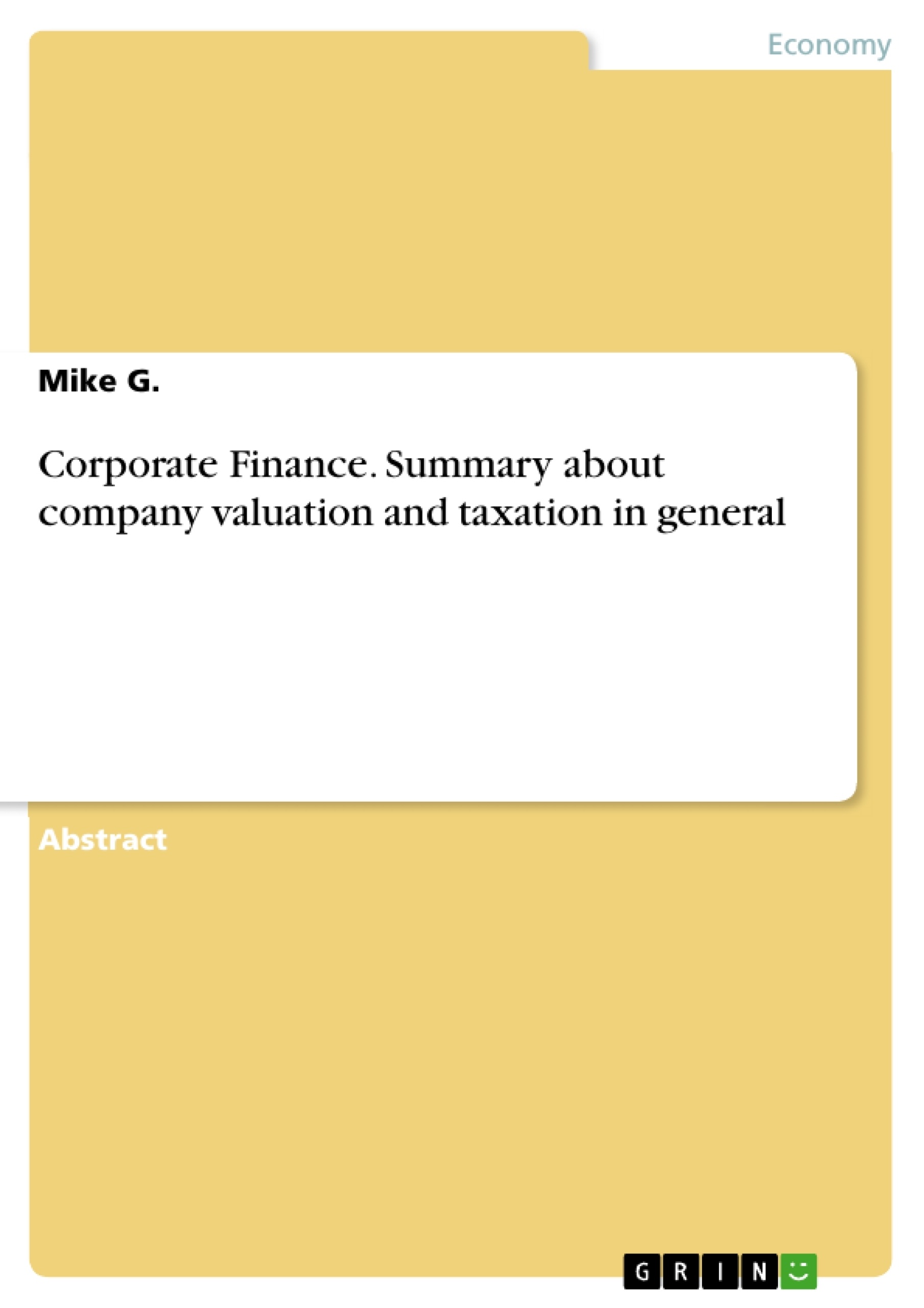This text is about a six-session-long lecture about the principles and advances in corporate finance. Two different professors taught about company valuation and taxation in general. Not only the transcript of the lecturers' speech, but also the board notes (captured in self-made pictures and tables) and some information from secondary literature / newspaper articles are included. It was composed for an upcoming exam for preparation purposes and, therefore, a summary of this content is added at the end. However, it is not only useful for exams, it also allows the reader to get a better knowledge about the basic principles ad theories of corporate finance.
This text is about a six-session-long lecture about the principles and advances in corporate finance. Two different professors taught about company valuation and taxation in general. Not only the transcript of the lecturers' speech, but also the board notes (captured in self-made pictures and tables) and some information from secondary literature / newspaper articles are included. It was composed for an upcoming exam for preparation purposes and, therefore, a summary of this content is added at the end. However, it is not only useful for exams, it also allows the reader to get a better knowledge about the basic principles ad theories of corporate finance.
• Goals and Governance of the firm.
◦ Two main financial decisions are: Where to get the money from (fund raising) and where to invest in (investment).
→ Typically separated but actually have many points in common.
◦ Investments can be find on the asset side of the balance sheet (+ OBS items and intangibles), raised funds on the right hand side.
◦ To make investors invest, you must provide an adequate return to meet their opportunity costs.
▪ Adequate means in comparison with similar investments, similar in maturity, liquidity and risk.
◦ Three major company types.
▪ Sole Proprietorship: One individual running the business, owner is manager and personal liable, no conflicts of interest.
▪ Partnership: Similar to sole proprietorship, but consists of multiple owners.
▪ Corporation: Stockholders are the managers, which leads to potential conflicts of interest (→ moral hazard).
• One Tier System vs. Two Tier System.
◦ Two-tier board.
▪ Shareholders' Meeting elects the Supervisory Board, which elects the Executive Board consisting of the managers running the company.
▪ Employee representatives are elected and become part of the supervisory board.
▪ Try to reduce the moral hazard, but doesn't ensure the implementation of shareholders' interests.
◦ One-tier board.
▪ The Shareholders' Meeting elects the Board of Directors consisting of internal directors and external directors (with advisory tasks) ruling the firm.
▪ External directors should take care about the implementation of shareholders' interests, but don't have those deep insights into the company, as the internal directors have.
• Shareholders vs. Stakeholders.
◦ Stakeholders have interest in the firm, Shareholders own parts of the firm.
◦ Both have cash flow and control rights.
▪ In case of receiving dividends, bond holders are preferred over shareholders, but in case of controlling it's the other way round.
▪ Bond holders only have a right to say in case of illiquidity of the firm.
◦ But the management should take care about the stakeholders → CSR.
◦ International differences in company orientation.
▪ Companies like Japan, France and Germany focus (very) much on stakeholders value whereas the Anglo-Saxon countries focus more on the shareholders value (due to Adam Smith?).
▪ Japan implemented employee loyalty by offering many perks as reaction of high mobility of specialists.
• Duties of the financial managers.
◦ Take care about the raise and use of funds, but also of the distribution of profits (reinvest or dividend).
◦ Major fields of action of a CFO are treasury and controlling.
▪ Treasury: Cash management, raising and usage of funds, etc.
▪ Controlling: Accounting book keeping.
• Valuation of Stocks.
◦ Characteristics of a common stock.
▪ Right for dividends as cash or share dividends.
▪ Payouts are uncertain in both magnitude and timing.
▪ Stockholders have limited liabilities as well as the four basic shareholder rights.
[...]
- Quote paper
- Mike G. (Author), 2017, Corporate Finance. Summary about company valuation and taxation in general, Munich, GRIN Verlag, https://www.grin.com/document/366654
-

-

-

-
Upload your own papers! Earn money and win an iPhone X. -

-
Upload your own papers! Earn money and win an iPhone X. -

-
Upload your own papers! Earn money and win an iPhone X. -

-
Upload your own papers! Earn money and win an iPhone X. -

-
Upload your own papers! Earn money and win an iPhone X. -

-
Upload your own papers! Earn money and win an iPhone X. -

-
Upload your own papers! Earn money and win an iPhone X. -

-
Upload your own papers! Earn money and win an iPhone X. -

-
Upload your own papers! Earn money and win an iPhone X.

